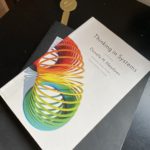A round-up of May reading, which was almost entirely non-fiction, aside from a read-aloud to the kids.
- The New Jim Crow — This is a very academic and in-depth account of the racial bias inherent in the American criminal justice system. It was genuinely eye-opening—even shocking—to see the extent to which legal precedents like McCleskey v. Kempbuttress the discriminatory application of drug laws against Black and minority populations. I almost abandoned this book in the preface to the 10th anniversary edition because I was finding it such a tough read. I’m so very glad I persevered, because it was absolutely worth it. But my advice would be to skip the preface and read it as an afterword.
- Remote Work Revolution — This is a new book from Tsedal Neeley, a professor at Harvard Business School. It has a lot of really interesting and useful tidbits in it, but I was wanting more in the way of an overarching framework or theory to pull it all together. To me, it feels like a book that was rushed to capitalize on the pandemic-driven rise of remote work. (Not really a criticism — it seems clearly better to have a book that is a bit rushed and relevant than a book that is really measured and has missed its moment.)
- Calm Within the Storm — This is a new book from Dr. Robyne Hanley-Dafoe, and I really wanted to like it. I so appreciate her five pillars of resiliency (belonging, perspective, hope, and humour), and find ‘you can do hard things’ to be an incredibly helpful mantra as a person and a parent. But I was looking for a book that provided a lot of academic and scholarly underpinnings, and this was not that book. If you are looking for a personal story with lots of anecdotes and quirky asides, then it might be the book for you.
- She Said: Breaking the Sexual Harassment Story That Helped Ignite a Movement — This was a behind-the-scenes account of how Jodi Kantor and Megan Twohey were able to break the Harvey Weinstein story — corroborate facts, get sources on the record, provide an opportunity for Weinstein to refute the allegations. Once we follow the story from lead to publication, it switches gears, into how Christine Blasey Ford came to testify at the Kavanaugh confirmation hearings. The contrast of the journalism process vs. the senate hearing process was an interesting one, and overall it was an enjoyable inside baseball kind of read. But not one that lit my world on fire.
- The Infinite Game — This is Simon Sinek’s newest offering. As always, he’s very beguiling with anecdotes and wraps it all into a snappy model. This time around, he is differentiating between finite and infinite mindsets, and advocating for the latter. He has a more revolutionary bent this time around, dredging up Milton Friedman and arguing against shareholder capitalism. The thesis of the book in a nutshell: “The responsibility of a business is to use its will and resources to advance a cause greater than itself, protect the people and places in which it operates, and generate more resources so that it can continue doing all those things for as long as possible.” If you don’t agree with that sentiment, I don’t think this book will do much to persuade you otherwise. But for me, the book aligned with my priors, so it was a pleasant and affirming read that invited some useful introspection.
- The Time Divide: Work, Family, and Gender Inequality — This is quite an old book now, published in 2004. Jerry Jacobs and Kathleen Gerson go deep on American attitudes towards time and the workplace, and provide all the data to back it up. Their organizing principle is that household composition is the main thing shaping perceptions of work-life balance: with so many more dual-income households and single-parent households, people are much more pinched for time even though average workweeks haven’t increased much. They highlight an increasing bifurcation in time spent at work, as there are more and more American couples working > 100 hours between them each week, and an increasing number who can’t get enough hours to support their cost of living. The main downside of the book is its age — most of the data is looking at changes from 1970–2000, so I’m curious how things have changed in the intervening two decades.
-
Babe, the Gallant Pig — This was a bedtime read-aloud with my kiddos. I didn’t even realize the movie Babe was based on a book, but it was a very charming book, and even held the attention of the three year old reasonably well. Strong recommend as a bedtime chapter book for the littlest kids.
